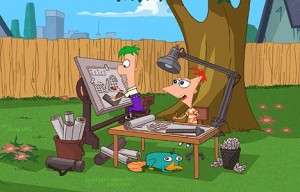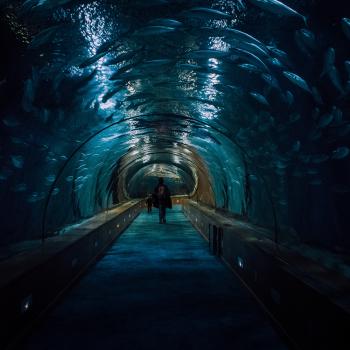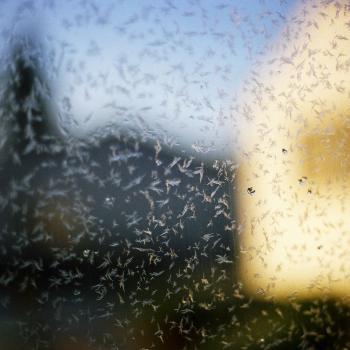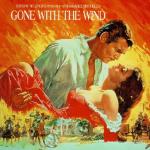 “Aren’t you a little young to save the universe?”
“Aren’t you a little young to save the universe?”
“Yes. Yes I am.”
Phineas Flynn gets questioned about his age a lot, which is to be expected when you are a three-foot wunderkind with a triangle head and expertise at building, with your silent half-brother, time-travel machines and antigravity devices.
Phineas and Ferb, a Disney Channel cartoon entering its fourth season, may be the smartest thing on television.
Stuck in perpetual summer, the show’s eponymous stars devise elaborate machines to entertain themselves and their friends, or to solve problems, like a shortage of the exotic berries their mother uses to bake pies. Their entertainment takes the form of city-spanning rollercoasters and floating trampolines, while their solution to the berry shortage includes a trebuchet and a device for contracting physical space.
There’s no question this is the most intelligent kids’ show around. While Phineas and Ferb are solving a seemingly intractable rotational physics problem, three channels away Spongebob Squarepants is trying to figure out how to keep his pants from ripping.
Phineas and Ferb is arguably the smartest adult show as well, if not the cleverest. Cleverest may be England’s Sherlock, what with the detective’s implacable ability to deduce facts from scratches on a cell phone, or a thin streak of mud on a victim’s stocking.
Sherlock is clever, just as Downton Abbey is gorgeous and plot-driven, but for sheer intellectual depth, the smart money is on Phineas and Ferb. This program has heft because its creators, Jeff Marsh and Dan Povenmire—who pitched it for sixteen years before finding a buyer—steep it in external referents.
Progressive scholar turned education reformer E.D. Hirsch notes that it’s no small thing, the fact that today we teach a child that “A is for apple,” whereas earlier generations of students learned “A is for Adam.” The modern child sees, next to the simpler mnemonic, an insanely red apple pierced by a friendly, anthropomorphized worm. The child a century ago saw this bracing couplet:
In Adam’s fall
We sinned all.
The precipitous decline of reading comprehension in the 1970’s, Hirsch claims, coincides with education innovations that denuded classrooms of cultural knowledge.
Exchanging the theological allusion for a worm with rosy cheeks is one reason modern students don’t know what it means when they read: “I wouldn’t know him from Adam,” or, “This park is like the garden before The Fall.”
Not only does this yield dumber people, it fosters dumber art. Writes Hirsch, “If I as a writer cannot predict what my unseen audience already knows, then I cannot know how to communicate with it.”
Any comedian will explain that you can communicate with an ignorant audience; you just have to talk about things they know.
“It was the best of times, it was the worst of times” may make no sense whatsoever to average Americans. Some boy’s obsession with a sled named Rosebud may befuddle audiences. And, they may have no patience with the jazz drummer who never cuts loose on the bass.
They will always be able to understand, however, farts and boobs. Or reality TV—marginally pretty people thrown together like cats in a sack, sniping about stolen toothpaste, or blouses borrowed without permission, or girlfriends who sleep around.
The artist’s alternative, in a community whose shared culture dwindles, is to craft worlds from whole cloth. Hence the success of Twilight and Harry Potter—nobody knows Shakespeare or the Bible anymore, but those of us still inclined to read can, rather than catching up on 500 years of Western civilization, simply internalize some rules about vampire mating, and how wizards get promoted to ninth grade.
If you stipulate that all art must either exploit physiological basics or invent alternate realities, you can predict the bulk of pop culture, whether it’s greasy thugs in a Jersey beach house, or a talking yellow rectangle who lives in a pineapple under the ocean.
Lost traditions push art toward primitivism and fantasy, but Phineas and Ferb proves that people are still drawn to something richer.
Most viewers probably won’t get the allusion, in the episode entitled “The Doonkelberry Imperative,” to the Big Enders versus Little Enders feud in Gulliver’s Travels, but they can still recognize how communities draw angry lines over small differences.
One needn’t have read Gulliver’s Travels to know that, of course, but the advantage, for the artist, of acquaintance with artistic tradition is that she can draw on hundreds of years of wisdom. She can tap into truths that resonate more deeply than whatever goody-goodness passes for moral education in the modern non-canon.
Phineas and Ferb proves that people will respond to that. Depending on what numbers you use, it’s already trouncing Spongebob Squarepants, not to mention more execrable Nickelodeon fare like Hey Gabba Gabba (imagine Satan as a fallen Muppet turned children’s show producer, and you’ll get an idea of the horror).
This is probably asking too much of a program targeted at six to eleven year olds, but maybe it can help rebuild a cultural foundation. Maybe when children get around to reading Moby Dick, they’ll fondly recall the cry of Phineas and Ferb’s meddlesome sister Candace in an episode: “From Danville Harbor I stab at thee!”
On the other hand, maybe just as the comical villain of the show, Dr. Doofenshmirtz, exclaims when no one laughs at his jokes, it’s casting pearls before swine. Watch an episode and decide for yourself.











